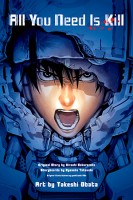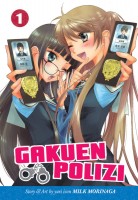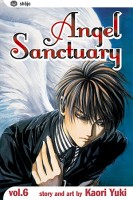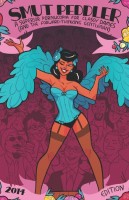My News and Reviews
Last week was a busy week for me as I was traveling and such for the Thanksgiving holiday, but Experiments in Manga had quite a few things going on, too. The most recent manga giveaway was posted and there’s still time to enter for a chance to win a Seven Seas Sampler—four first volumes of some of Seven Seas’ manga series. I also posted two reviews last week. First up was Yu Godai’s novel Quantum Devil Saga: Avatar Tuner, Volume 1 which I loved. It’s based on the same story as Digital Devil Saga, a spinoff of the Shin Megami Tensei video game series. I also reviewed Ryosuke Takeuchi and Takeshi Obata’s All You Need Is Kill manga adaptation of Hiroshi Sakurazaka’s original All You Need Is Kill novel. I think the novel is the stronger of the two, but I enjoyed the manga as well. Last week I also joined in with the other Manga Bookshelf bloggers for a roundtable on food manga over at MangaBlog.
I should also probably mention that the votes have been tallied for my next monthly manga review project. After School Nightmare took an early lead, but it ended up being a very close contest between it and Dorohedoro and Mushishi. And in the end, After School Nightmare and Mushishi actually tied with each other! So, I’ve decided to review both manga. There are a few different ways to approach this, but beginning with After School Nightmare, each month I’ll alternate between the two series. If everything goes according to schedule, it should take me a year and a half to complete the review project. Thank you to everyone who participated in the poll! I was very glad to see interest expressed in all of the series to which I had narrowed down the vote. I’ll be sure to keep in mind the other series that were strongly supported and try to feature them as best as I can, too. I wish that I had more time to read and write!
Elsewhere online, Organization Anti-Social Geniuses had a couple of posts that I found particularly interesting last week—an interview with Abigail Blackman, one of Yen Press’ editors and letterers, and a discussion of some of the fears of buying manga from U.S. publishers. Digital Manga has launched yet another Osamu Tezuka manga Kickstarter, though one that seems much more reasonable than the last failed project. This time, Digital Manga is trying to raise funding for the publication of Tezuka’s Ludwig B, an unfinished manga series about Beethoven. (In part because of my background in music, I’m actually really interested in Ludwig B.) I’d also like to bring a little attention to an effort started by Becca Hillburn—a group for Western Shoujo Comic Artists. More about it and the endeavor to create a network of support for manga-influenced artists can be read at Hillburn’s website Nattosoup: Solidarity and the American Shoujo/Josei Comic Scene.
Quick Takes
 Alice in the Country of Hearts, Omnibus 1 (equivalent to Volumes 1-2) by Soumei Hoshino. Based on an otome game by Quin Rose, Hoshino’s Alice in the Country of Hearts is one of many manga adaptations and spinoffs. Originally the series was partially released in English by Tokyopop, but the license was later rescued by Yen Press. Despite hearing good things about Alice in the Country of Hears, one of the reasons it took me so long to give the manga a try was the sheer number of volumes associated with the franchise. I’m glad that I finally got around to reading the first omnibus, though, because I loved it. At first, Alice in the Country of Hearts seems like a fairly straightforward re-imagining of Lewis Carroll’s Alice’s Adventures in Wonderland. (Granted, many of the characters are now bishōnen of various types.) But it soon becomes clear that something very ominous and disconcerting is brewing under the story’s surface. Alice has been transported to Wonderland and if she ever wants to return home she will have to get to know its residents better. Although they are participating in some sort of game to win her affections, those who live in Wonderland are prone to violence and have a very different sense of what is normal.
Alice in the Country of Hearts, Omnibus 1 (equivalent to Volumes 1-2) by Soumei Hoshino. Based on an otome game by Quin Rose, Hoshino’s Alice in the Country of Hearts is one of many manga adaptations and spinoffs. Originally the series was partially released in English by Tokyopop, but the license was later rescued by Yen Press. Despite hearing good things about Alice in the Country of Hears, one of the reasons it took me so long to give the manga a try was the sheer number of volumes associated with the franchise. I’m glad that I finally got around to reading the first omnibus, though, because I loved it. At first, Alice in the Country of Hearts seems like a fairly straightforward re-imagining of Lewis Carroll’s Alice’s Adventures in Wonderland. (Granted, many of the characters are now bishōnen of various types.) But it soon becomes clear that something very ominous and disconcerting is brewing under the story’s surface. Alice has been transported to Wonderland and if she ever wants to return home she will have to get to know its residents better. Although they are participating in some sort of game to win her affections, those who live in Wonderland are prone to violence and have a very different sense of what is normal.
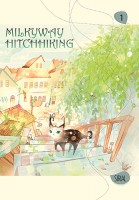 Milkyway Hitchhiking, Omnibus 1 (equivalent to Volumes 1-2) by Sirial. Although occasionally the same characters make an appearance in multiple stories, Milkyway Hitchhiking is generally an episodic manhwa. The only thing that really ties the volume together is the presence of Milkyway, a beautiful cat who can apparently travel through space and time. She may or may not actually play an active role in the stories being told. Sometimes she’s just an observer and sometimes she’s a participant. Sometimes she’s a focal point of a tale and sometimes she simply happens to be present while events unfold around her. The most striking thing about Milkyway Hitchhiking is its beautiful, full-color artwork. Some of the individual illustrations are simply stunningly gorgeous. A variety of color palettes are used to lovely effect. While I particularly appreciate Milkyway Hitchhiking for Sirial’s art, I also enjoyed the individual episodes, too. The stories range from the fantastical to those grounded in reality. Some feel very much like something out of a fairy tale while others are contemporary slice-of-life or historical in nature. At times heartwarming and at times heartbreaking, I very much enjoyed Milkyway Hitchhiking and look forward to reading more of the series.
Milkyway Hitchhiking, Omnibus 1 (equivalent to Volumes 1-2) by Sirial. Although occasionally the same characters make an appearance in multiple stories, Milkyway Hitchhiking is generally an episodic manhwa. The only thing that really ties the volume together is the presence of Milkyway, a beautiful cat who can apparently travel through space and time. She may or may not actually play an active role in the stories being told. Sometimes she’s just an observer and sometimes she’s a participant. Sometimes she’s a focal point of a tale and sometimes she simply happens to be present while events unfold around her. The most striking thing about Milkyway Hitchhiking is its beautiful, full-color artwork. Some of the individual illustrations are simply stunningly gorgeous. A variety of color palettes are used to lovely effect. While I particularly appreciate Milkyway Hitchhiking for Sirial’s art, I also enjoyed the individual episodes, too. The stories range from the fantastical to those grounded in reality. Some feel very much like something out of a fairy tale while others are contemporary slice-of-life or historical in nature. At times heartwarming and at times heartbreaking, I very much enjoyed Milkyway Hitchhiking and look forward to reading more of the series.
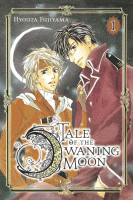 Tale of the Waning Moon, Volume 1 by Hyouta Fujiyama. I have a tendency to forget that Yen Press releases boys’ love series. Tale of the Waning Moon is one of those manga. Fujiyama has had quite a few of her works released in English, but I haven’t read any until now. Tale of the Waning Moon is pretty ridiculous. Ryuka is a young man whose girlfriend recently left him for another man. While drowning his sorrows Ryuka accidentally calls upon Ixto, the spirit of the last quarter moon, to grant him true love. The twist is that all of the eligible candidates that Ixto comes up with are men, which doesn’t particularly appeal to Ryuka. The real problem is that when Ryuka rejects those options, he comes under Ixto’s spell and is therefore compelled to leave his village on a quest to reunite with the spirit. From there, Ryuka sets of on his journey, unintentionally amassing an adventuring party of sorts in the process. Tale of the Waning Moon has sex (not all of it consensual) and silliness, magic and mayhem. Inspired and heavily influenced by fantasy RPGs, the manga is definitely more of a comedy than it is a romance. Tale of the Waning Moon is a short series—only four volumes—and the first installment entertained me well enough, so I’ll probably get around to picking up the rest at some point.
Tale of the Waning Moon, Volume 1 by Hyouta Fujiyama. I have a tendency to forget that Yen Press releases boys’ love series. Tale of the Waning Moon is one of those manga. Fujiyama has had quite a few of her works released in English, but I haven’t read any until now. Tale of the Waning Moon is pretty ridiculous. Ryuka is a young man whose girlfriend recently left him for another man. While drowning his sorrows Ryuka accidentally calls upon Ixto, the spirit of the last quarter moon, to grant him true love. The twist is that all of the eligible candidates that Ixto comes up with are men, which doesn’t particularly appeal to Ryuka. The real problem is that when Ryuka rejects those options, he comes under Ixto’s spell and is therefore compelled to leave his village on a quest to reunite with the spirit. From there, Ryuka sets of on his journey, unintentionally amassing an adventuring party of sorts in the process. Tale of the Waning Moon has sex (not all of it consensual) and silliness, magic and mayhem. Inspired and heavily influenced by fantasy RPGs, the manga is definitely more of a comedy than it is a romance. Tale of the Waning Moon is a short series—only four volumes—and the first installment entertained me well enough, so I’ll probably get around to picking up the rest at some point.
 Übel Blatt, Omnibus 0 (equivalent to Volumes 0-1) by Etorouji Shiono. Übel Blatt, which translates as “evil blade,” has a lot going for it that generally appeals to me—a dark fantasy setting, a tale of revenge, epic battles, and so on—but for some reason, the first omnibus (the zeroth omnibus?) didn’t quite grab me as much as I expected it to. I’m not really sure why, since it seems like a series that should interest me. In fact, overall I actually did like the story. I even like many of the characters, especially its lead. But there were a few little (and big) things here and there that just didn’t work for me. For one, the sexual content and rape in the volume seems entirely unnecessary. It comes across as a superfluous attempt to add more edginess as opposed to being important to the story. Most of the female characters don’t fare particularly well, either. Occasionally there’s a little bit of hope that they’ll overcome their scantily clad fantasy tropes, but it never quite seems to happen. At this point, many of the antagonists in Übel Blatt seem fairly one-dimensional, too, though I suspect that this will change as the series progresses. All that being said, Übel Blatt does feature some excellent fight sequences and scenes of destruction. And while I’m not desperate to read the next volume, the series does show potential.
Übel Blatt, Omnibus 0 (equivalent to Volumes 0-1) by Etorouji Shiono. Übel Blatt, which translates as “evil blade,” has a lot going for it that generally appeals to me—a dark fantasy setting, a tale of revenge, epic battles, and so on—but for some reason, the first omnibus (the zeroth omnibus?) didn’t quite grab me as much as I expected it to. I’m not really sure why, since it seems like a series that should interest me. In fact, overall I actually did like the story. I even like many of the characters, especially its lead. But there were a few little (and big) things here and there that just didn’t work for me. For one, the sexual content and rape in the volume seems entirely unnecessary. It comes across as a superfluous attempt to add more edginess as opposed to being important to the story. Most of the female characters don’t fare particularly well, either. Occasionally there’s a little bit of hope that they’ll overcome their scantily clad fantasy tropes, but it never quite seems to happen. At this point, many of the antagonists in Übel Blatt seem fairly one-dimensional, too, though I suspect that this will change as the series progresses. All that being said, Übel Blatt does feature some excellent fight sequences and scenes of destruction. And while I’m not desperate to read the next volume, the series does show potential.

